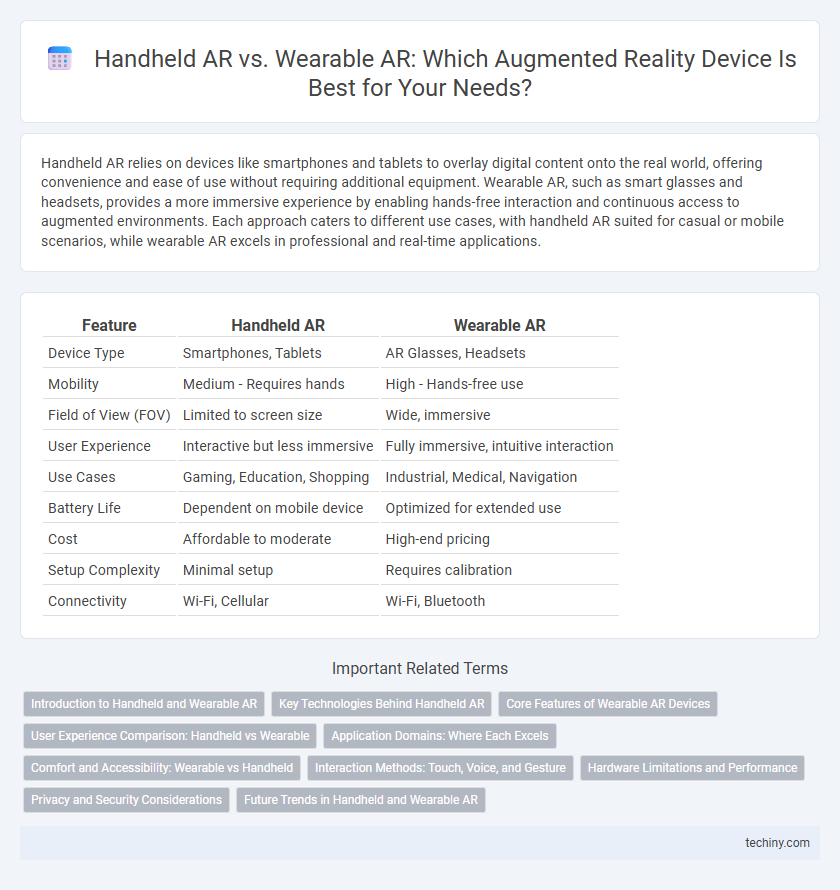Handheld AR relies on devices like smartphones and tablets to overlay digital content onto the real world, offering convenience and ease of use without requiring additional equipment. Wearable AR, such as smart glasses and headsets, provides a more immersive experience by enabling hands-free interaction and continuous access to augmented environments. Each approach caters to different use cases, with handheld AR suited for casual or mobile scenarios, while wearable AR excels in professional and real-time applications.
Table of Comparison
| Feature | Handheld AR | Wearable AR |
|---|---|---|
| Device Type | Smartphones, Tablets | AR Glasses, Headsets |
| Mobility | Medium - Requires hands | High - Hands-free use |
| Field of View (FOV) | Limited to screen size | Wide, immersive |
| User Experience | Interactive but less immersive | Fully immersive, intuitive interaction |
| Use Cases | Gaming, Education, Shopping | Industrial, Medical, Navigation |
| Battery Life | Dependent on mobile device | Optimized for extended use |
| Cost | Affordable to moderate | High-end pricing |
| Setup Complexity | Minimal setup | Requires calibration |
| Connectivity | Wi-Fi, Cellular | Wi-Fi, Bluetooth |
Introduction to Handheld and Wearable AR
Handheld AR devices, such as smartphones and tablets, utilize built-in cameras and sensors to overlay digital content onto the physical environment, offering accessible and portable augmented reality experiences. Wearable AR devices, including smart glasses and headsets, provide a hands-free and immersive interaction by projecting digital information directly within the user's field of view. Both handheld and wearable AR technologies enhance real-world perception but differ significantly in terms of mobility, user interaction, and application scenarios.
Key Technologies Behind Handheld AR
Handheld AR primarily relies on smartphone or tablet cameras, GPS sensors, and accelerometers to overlay digital content onto the real world, enabling precise motion tracking and spatial awareness. Computer vision algorithms, including Simultaneous Localization and Mapping (SLAM), play a crucial role in detecting surfaces and positioning virtual objects accurately in real time. Advanced processors and machine learning models optimize image recognition and object detection, enhancing interactive and immersive experiences on mobile devices.
Core Features of Wearable AR Devices
Wearable AR devices offer hands-free interaction, allowing users to access augmented content through smart glasses or headsets, improving mobility and user experience compared to handheld AR. These devices typically feature advanced sensors, spatial mapping, and real-time environmental understanding, enabling precise overlay of digital information onto the physical world. Enhanced battery life, voice command integration, and ergonomic design further distinguish wearable AR, making them ideal for industrial, medical, and field applications.
User Experience Comparison: Handheld vs Wearable
Handheld AR offers intuitive interactions through familiar touchscreen controls, providing immediate access to augmented content with limited mobility constraints, making it ideal for casual or on-the-go use. Wearable AR devices, such as smart glasses, deliver a hands-free, immersive experience with enhanced spatial awareness, allowing continuous real-time overlays that improve engagement and multitasking capabilities. User experience favors handheld AR for ease of use and accessibility, while wearable AR excels in providing seamless integration and prolonged interaction in dynamic environments.
Application Domains: Where Each Excels
Handheld AR excels in retail and education by offering interactive product visualization and immersive learning experiences through smartphones and tablets, enabling easy accessibility and user engagement. Wearable AR is dominant in industrial maintenance, healthcare, and logistics, providing hands-free, real-time data overlay and remote assistance that enhance productivity and safety. Both technologies complement each other by addressing distinct application domains optimized for portability or hands-free interaction.
Comfort and Accessibility: Wearable vs Handheld
Wearable AR devices offer superior comfort for prolonged use through ergonomic designs that distribute weight evenly and allow hands-free interaction, enhancing accessibility in active environments. Handheld AR relies on mobile devices, which can cause fatigue due to continuous holding and limited field of view, reducing comfort during extended sessions. Accessibility in wearable AR is improved by intuitive gesture controls and seamless integration into daily activities, whereas handheld AR depends on device portability and screen size constraints.
Interaction Methods: Touch, Voice, and Gesture
Handheld AR primarily relies on touch-based interaction through smartphones or tablets, offering intuitive control via taps and swipes on screens. Wearable AR devices incorporate advanced voice commands and gesture recognition, enabling hands-free operation and more immersive experiences. Combining touch, voice, and gesture inputs enhances user engagement by providing versatile interaction methods tailored to different AR platforms.
Hardware Limitations and Performance
Handheld AR devices, such as smartphones and tablets, face hardware limitations including smaller battery capacity and less powerful processors, which can lead to reduced performance and shorter usage times during AR applications. Wearable AR devices, like smart glasses and headsets, typically offer more optimized hardware for AR experiences with dedicated sensors and processors, but they often confront challenges related to limited field of view and thermal management. Both types must balance processing power, battery life, and user comfort to achieve smooth, immersive augmented reality performance.
Privacy and Security Considerations
Handheld AR devices, such as smartphones and tablets, offer more user-controlled data access, allowing easier management of app permissions and limiting data exposure compared to wearable AR devices. Wearable AR, including smart glasses, continuously collects sensitive biometric and environmental data, increasing privacy risks and potential for unauthorized surveillance. Enhanced encryption protocols and rigorous security frameworks are essential to mitigate data breaches and ensure user confidentiality in both handheld and wearable AR ecosystems.
Future Trends in Handheld and Wearable AR
Future trends in handheld AR emphasize enhanced processing power, improved battery life, and integration with 5G networks, enabling seamless real-time data visualization and interactive experiences. Wearable AR is advancing through miniaturization, improved optics like waveguide displays, and AI-powered contextual awareness, driving adoption in enterprise, healthcare, and consumer markets. Both platforms are converging on hybrid models combining mobility and immersive capabilities, shaping the next generation of AR applications.
Handheld AR vs Wearable AR Infographic

 techiny.com
techiny.com